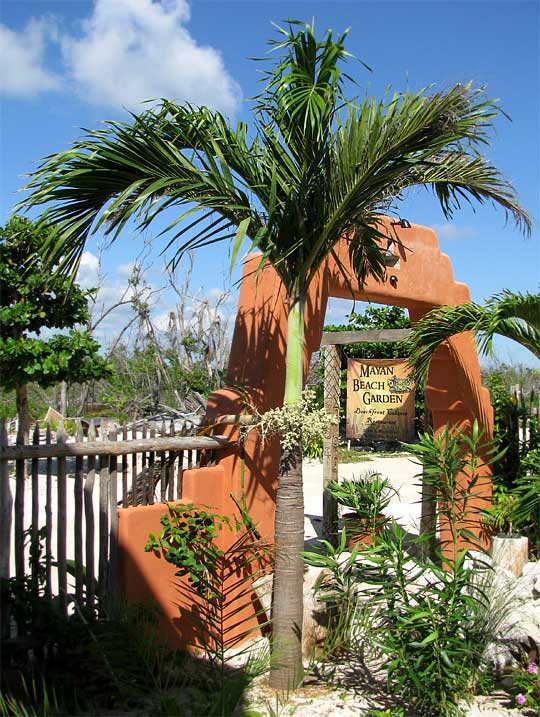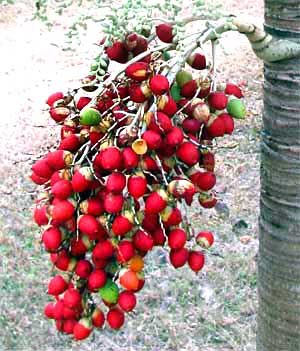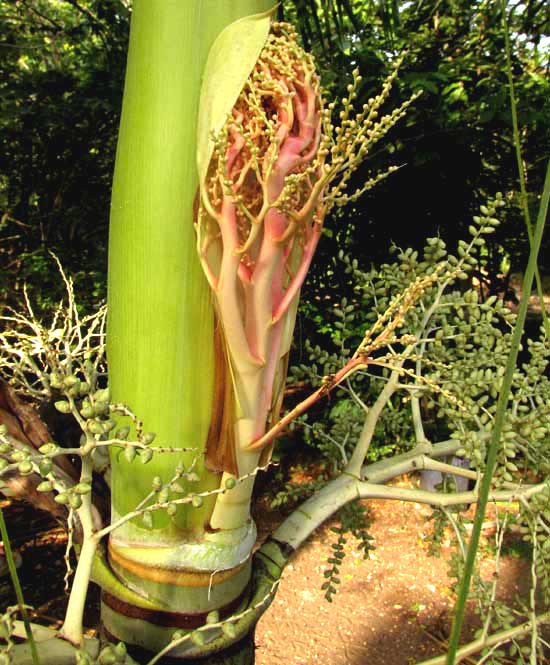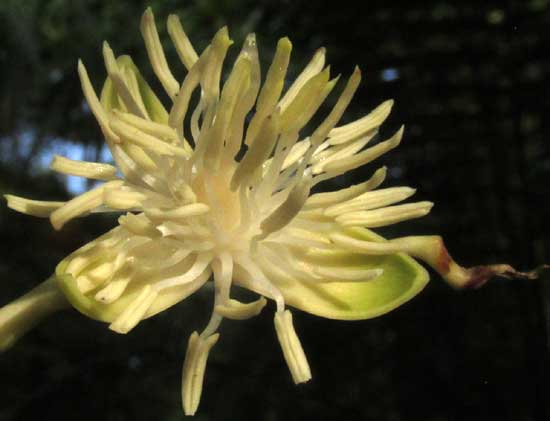Excerpts from Jim Conrad's
Naturalist Newsletter
from the December 15, 2008 Newsletter written at Mayan Beach Garden Resort 20 kms north of Mahahual; Caribbean coastal beach and mangroves, ~N18.89°, ~W87.64°, Quintana Roo state, MÉXICO
MANILA PALM

Above you see the handsome, smallish, feather-leafed or pinnate-leafed palm at the entrance to Mayan Beach Garden. Palm fanciers may recognize it as a close relative to the famous, stately, much larger Royal Palm.
This is a much-planted species native to the Philippines, ADONIDIA MERRILLII. Since it's planted so extensively it goes by many names. In the US often it's called Christmas Palm because it produces olive-size red fruits but internationally it seems to be best known as Manila Palm, and of course some call it Dwarf Royal Palm. Notice the curious way the flowers arise midway the trunk.

Above you see a honeybee lifting from one of its flowers. These palms are monoecious, meaning that individual trees bear unisexual flowers of both sexes. In the picture you can make out an oval ovary amidst the cluster of pollen-producing stamens, so that ovary must be sterile, because the stamens seem to be doing a good job producing white pollen. Notice the pollen bag on the honeybee's back leg.
Below you can see a cluster of ADONIDIA nuts, photographed in the northern Yucatan.

from the July 13, 2018 Newsletter issued from Rancho Regenesis in the woods ±4kms west of Ek Balam Ruins; elevation ~40m (~130 ft), N~20.876°, W~88.170°, central Yucatán, MÉXICO
A MANILA PALM'S BURSTING FLOWER BUD
This week the big flower bud of a Manila Palm at the rancho burst open, exposing its immature panicle of flowers, shown below:

In that picture, notice the large, scoop-shaped spathe that earlier entirely covered and protected the flower cluster. Now the enlarging flower cluster is pushing the spathe upward, so that the spathe has come lose at its browning base. The flower cluster's thick branches are rosy colored, in anticipation of the strikingly red fruits.
Below the flower cluster's juncture with the trunk, notice the pale ring encircling the trunk. The ring is the scar left by the trunk-enveloping base of the petiole of the last frond to be shed from the growing tree. Many palm trunk species display such rings.
from the July 20, 2018 Newsletter issued from Rancho Regenesis in the woods ±4kms west of Ek Balam Ruins; elevation ~40m (~130 ft), N~20.876°, W~88.170°, central Yucatán, MÉXICO
THE MANILA PALM'S MALE & FEMALE FLOWERS
Manila Palms are "monoecious," meaning that they produce unisexual flowers, with individual trees bearing flowers of only one sex. Below, you can see a marble-size male, or "staminate," flower bristling with cream-colored, pollen-producing stamens:

The male flowers of most palm species produce only six stamens, so bearing so many is a little unusual. In the blossom's center you can barely make out a spherical item exactly where the female ovary should be. That's a vestigial ovary, destined to never produce a fruit despite being surrounded by so many vigorous male parts. Another Manila Palm standing just a few feet away was loaded with very different-looking female flowers, two of which are shown below:

The three fresh-looking, curved stigma arms at the flowers' tops indicate that the ovaries are receptive, ready to receive pollen from a male tree. Notice the stigma arms' rough or maybe short-hairy upper surfaces, which help airborne pollen grains stick there when they land. Also, notice at the ovary's base the six broad, rounded scales representing the flower's three sepals and three petals. When the ovary matures into a fruit these scales will form a conspicuous, pale, tough, cuplike item known as a "cupule," and will look somewhat like an acorn's cup subtending the nut, which in the Manila Palm's case is bright red, so the cupule is very noticeable.